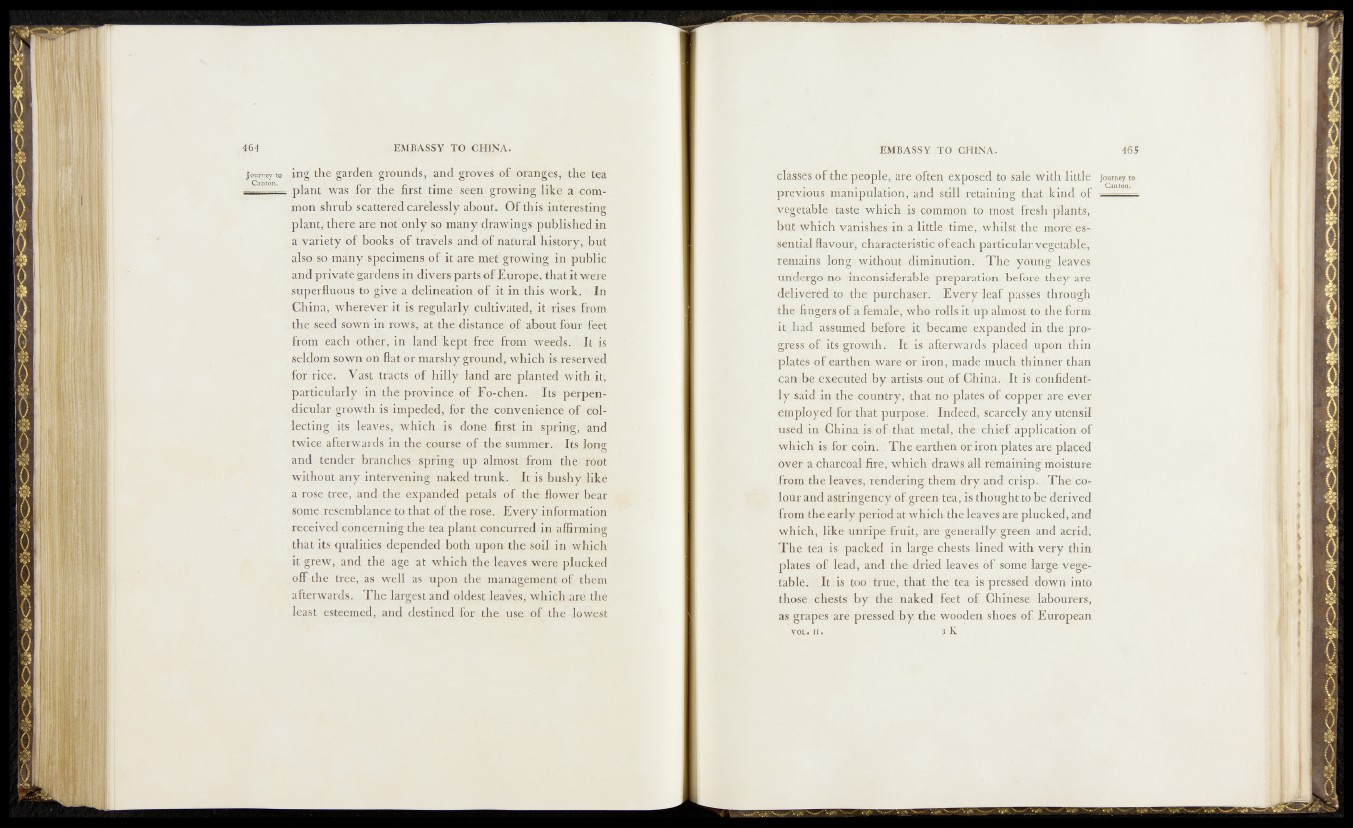
jjÉÉjëHjo' ing the; garden glpunds, and; groves o f’-oranges; the tea
' planbswas for then first time!seeni groyv-ingdike a-common
sh'rubr scattered carelessly; about. Of this interesting
plant, there-are not’ onlyiso'many drawings published in
a variety of b o o k so f travels and. of natural history, but
ah’oJ|p many specimens (ofoit are met growing in public
and private gardens in divers-parts of Europe,* that it were
superfluous to give a. delineation of it in this-Work
China, wherever i t is regularlyculdvatedsit -ris,e^fro«t
theiseedlsoWn in rows, a tth e distahaeiof about foUSSfeet
frbin Jeach QtJjhf, in land keptofreé from, weeds.yTtsfs
seldom sown,on flat, or marshjggmupdi which isjffesè^yed
for riceifl Vast tracts of hilly landlare^plapteéf w ith in
particularly in theprovince,-of Fo-^hen. Its perpendicular
growth is impeded, for the cön^endoMcè'óf-'collecting!
its leaves', which is done,firs^in> Spr'kig]-?Snd
twice afterwards in the coarse of the summer# Itslp^g
and tended branches -spring # p almosti^frorn theMrèpt
without any intervening'-naked'trunk. Iris bushy-like
a rose tree, and the, expanded petal^óf the, flow^ei^b'ear
some refeemblance to that- of the rose. - Every information
received concerning the tea plant coneürredjiU".af&rmifejg
that its qualities depended both upon the; soil in which
it grew, and the age at which the leaves were -plucked
off the tree,'as well as upon the management of "them
afterwards. The largest and; qldest .leaves^ which arë the
least, esteemed, and destined for the use of thqUlowest
ol^sesidf theypeopley are 'often expdsdditb* sale ydth little journey to
prevjjlpus^mainipulaihon^andvSitall: retaiaiihgi that, kind of . ■
^gg%ab|efs tafSte: 1 w,hif H'j isj comm©# t'^Vtoiost fresh qilan ts,
bub-'Whiqh, vanishes,in a little timev>$®hilst the mbl’^esj
sential flavoifiTro^aracterisfre^fteadh piyiseulfr! vegetable’;
regains Ibngjjwifchokit diminution'! Thenyoxingy leaves
undergone dncofosiderabteiprepafeafromillm^rfe^thepiafe
t^eliiVierfeditootb^fjpurchasef. .-'Eh^yrfeaf .pas|es, through
t, he-fingers,©fta female,, whojrolls, it up; a-lmoshto’ithe fmfriii
it- bad assumed before, it be came rfp'pan^l^^k1 tbespro.-
g^essoeff its growths It.-isi^ftebw.ajds. piteoedhpon: thin
plates q5'earth©niwar^norjiron,;madf'tm'iich thinner than
ejftybpie&ecuted.by artists roafJOfvChflna. It isiconfiderit!-
l^sifid .in th e ^ u h try 9ithafen.6:platfi.^&®np.pefarg;ever
Hmployed^fok'that pur.pds.el ThdfeeiJ; bcardely-any utensil
u. sed iin ChihadsLtafftha;b;meta?l,;theaehief application of
^vh4'?h,-is for cpin. I The ear thenor iron plateifareiplaqed
over a charcoalfire, which! draws all remaining'moisture
from thedeaves;.rendering (them-drytaod;cra^^ Theioo>
lour and aStriogene^t of green tea,iis thcJaght^jsSpe derived
from,t he .early period at which thefeaveesarle plucked,land
•wJiicfh;■ like*unripe fruit, are igenerally^green«and acrid:;
^Ghe-fea dsl packed in large* che'sfen lined withr&eryThin
plates'mf lead, and tbeadfieddeav'es' hf, isomellarge vb^e-
table. It,is too true,That the tea is'piessedrd'own into
thos<§ Thests by! the naked! feet /ofoChinese^labourers,
as grapes*are ,pressed* by the wooden shoesfoB European
yoL. ii. I K 1